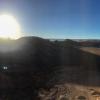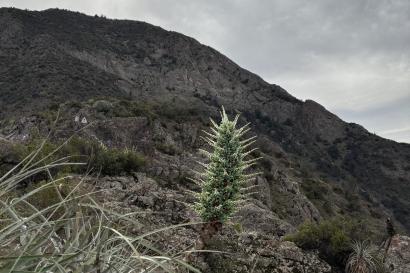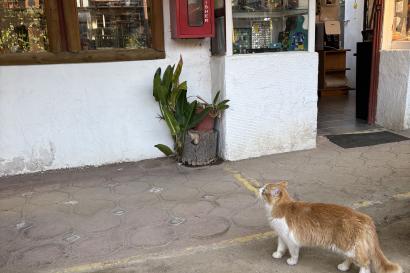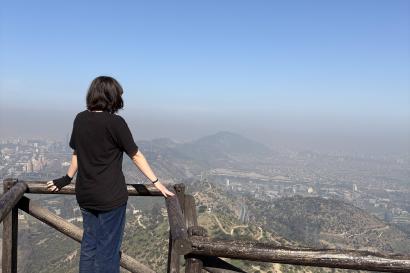Every day up until the last week of my homestay, my Chilean parents would ask me “Estai acostumbrada? Are you getting settled in?” I would always tell them that yes, I was finding this and that easier than before, but still didn’t know the mechanisms of this thing, etc. It opened the door to many enlightening conversations for me during my program in Santiago. But the day after my IES summer internship program ended in Chile, I boarded a flight at the Santiago airport to one of the most remote places on Earth.
I was going alone. Although I had traveled solo before, Easter Island would be the farthest I had ever gone in the world by myself. The flight from Santiago is 5 hours one-way. The airport consisted of a single landing strip and a baggage claim carousel inside of a building the size of a gas station.
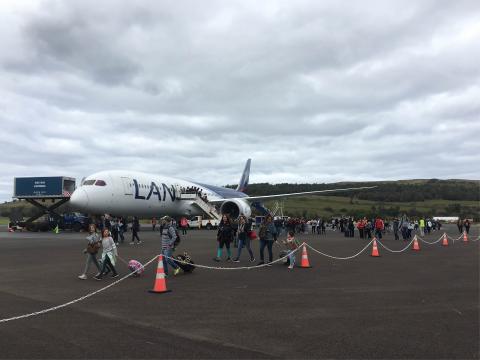
The Easter Island Airport
The main town Hanga Roa was less than a mile away from the airport, so I walked north, thinking that I should have written down the address of my Airbnb before leaving Santiago. Although I had bought an international data plan from my U.S. carrier back home, the signal was nonexistent out here (and it wouldn’t get better the two days I was there, either). On top of that, the Wi-Fi that the Airbnb had advertised wouldn’t work. I was in for two days of old-fashioned, internet-less adventure.
I eventually found my Airbnb since there was only one main road in the town. Right away, I dumped my backpack and started walking around. The mix of Polynesian and Chilean influence in the history of Easter Island, also known by its indigenous name Rapa Nui, has created a distinct culture unlike any other oceanic/Polynesian island in the Pacific. Spanish is the official language of the island, but local Rapanui also speak Rapa Nui, a Polynesian language like Tahitian. Due to the strength of the tourism industry, English and European languages like German and French are also popular. Easter Island also has three official currencies: the Chilean peso, the American dollar, and the Euro. The restaurants were predictably expensive, so I opted for take-away sushi most of the time. There’s no better place to eat fresh tuna.
I rented a car for the next morning to see the rest of the island.
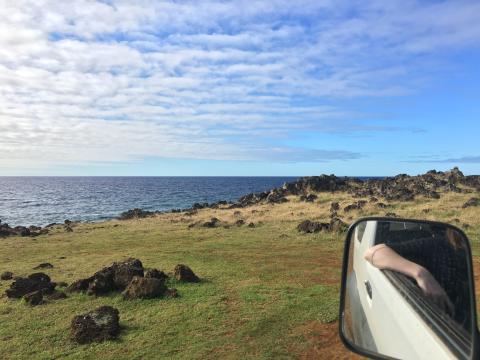
the northern coast of Rapa Nui
Most of the island (and all the Moai sites) is a national park. U.S. citizens need to buy a ticket to enter most of the sites for the equivalent of $80 USD, cash only (in Chilean pesos, Euros, or USD). The ticket used to be paid to the Chilean State, but a few years ago the locals revolted against that tax and decided that the Rapanui should get the profit of national park tickets sold, so the law was reformed. The entry ticket allows you unlimited visits to most of the Moai sites and a one-time pass to Tongariki, site of the iconic 15 Moai lineup, and the ruins of the Orongo village, home of the ‘birdman’ cult.

The Rano Kau wetland inside a volcanic crater
On the south end of the island, next to a huge crater housing the Rano Kau wetland, lay the ruins of an occult village.

the ruins of a home in Orongo
The people in this ancient society worshipped the migratory Sooty Tern. The bird would lay their eggs on a craggy rock off the southern coast, and whoever swam to the rock and returned with the first egg of spring would be crowned the ‘birdman’ and would be the village ruler for the year.

The closest and pointiest island is where the Sooty Tern would lay its eggs
Finally, Moai. They’re believed to have been created by the ancient villagers in the likeness of powerful chiefs. The Moai lay scattered across the island; some coastal platform sites stand barren with a missing or fallen statue. At Ahu Tongariki stand the iconic fifteen, the largest lineup of Moai. On the backside of the volcano across from the Tongariki Moai, abandoned Moai lay scattered across the foothill and up the grassy side.
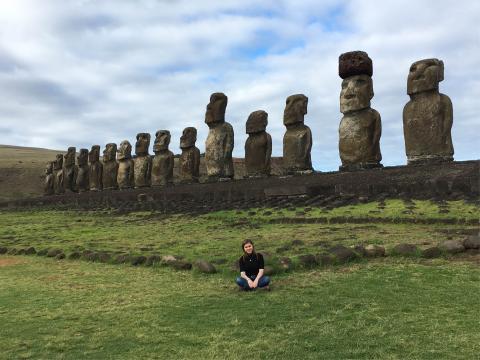

author at Ahu Tongariki
Other memorable Moai lineups are the seven at Anakena beach, the ‘cradle’ of Rapa Nui, and Ahu Tahai on the west coast.

The Moai at Anakena
A 5-minute drive east of Anakena is Ovahe beach, a little hidden inlet accessible through a nearly-undrivable dirt road. Here, the coast is the site of the ancient cemetery where islanders’ ashes would be given back to the sea.
I sat on the beach and watched the waves for a while, wondering if I was a little crazy for coming here alone, but it had been the most liberating experience of my life. What it must have been like to live an entire life on an island fourteen miles long and seven miles wide? To worship the birds and their eggs since they come from beyond the water? I would have thought they were gods, too.
Now, I’m back in the U.S., in my home state of Texas. I’ve given out my souvenir gifts and bared my pale skin to the Texas sun after living in the South American winter. I went tubing on the Comal River with my friends who got married while I was abroad (though a bridesmaid |Facetimed the ceremony live for me). Life goes on, and I’m a different person now. I’ve been to more places and seen so many things than before. Experienced so much. I’m nostalgic. But life has been going on for everyone else back home too. I’m re-integrating back into that after finally having settled into the Chilean way of life and my routine there. I’m settling in again, briefly, before my final semester at college. It goes on. I settle in, get acostumbrada, and then leave for my next adventure.

Rebecca Carey
<p>Rebecca Carey has been an avid literature and science fiction fan since reading her father’s copy of Ron Hubbard’s “Battlefield Earth” as a child. She has been writing professionally for two years and has published prose, poetry, and short fiction in the University of Iowa’s undergraduate literary reviews ‘InkLit,’ ‘Witness,’ and ‘Peripheral’ in 2018 and 2019, and has published poetry translations in the University of Iowa’s undergraduate translation Journal ‘Boundless’ in 2019. She is a Creative Writing and Translation student at the Univerisity of Iowa hoping to pursue a Master’s degree in translation studies after graduation. When she isn’t buried in a book, she’s usually somewhere in between the realm of overthinking, daydreaming, and wishing she was born 500 years in the future so she could have lived on Mars. Favorite novels of hers include Trenton Lee Stwart’s “The Mysterious Benedict Society,” Jeff Vandermeer’s “Annihilation,” and William Burrough’s “Naked Lunch.” Some of her favorite Chilean authors are Lina Meruane, Roberto Balaño, and Pablo Neruda.</p>



